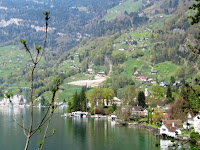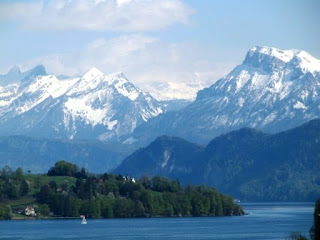14th to 20th April 2011
So the trip draws to a close - almost a year away in a smallish van. Twenty-one countries have been visited, some for several weeks, one for less than 24 hours and a few twice, and this final leg sees us heading home.
We decided to make the most of driving back by pulling in a few days around the Black Forest in Germany. We crossed the Rhine at Laufenburg, one city but two countries, being half in Switzerland and half in Germany, and stopped a few kilometres down the road at Luttingen where we shopped for meat at a wonderful butcher’s. Having found shopping in Switzerland a bit limited in terms of good local shops and cost, we were now spoilt for choice with such lovely looking produce at prices which didn’t make us wince, baulk or pale.
Black Forest – Menzenschwand – village and stellplatz, and sunset at Eisenbach - Höchstberg
We drove up a gorge to St. Blasien, and ended the day on a little stellplatz on the edge of the pretty village of Menzenschwand. The massive farmhouses in the village were fairly typical of the area, with hefty stone ground floors and a couple of timber storeys above. They tend to be built on a bit of a hill – and there are plenty of those around here – with the rear entrance leading straight into the hay barn on the first floor. The animals used to live below this hay barn, while the living area was on first floor, with its windows facing the best view. The enormous shingle roofs of these farmhouses create a striking impression from afar. A few are still in use as farms, but a great many more are guesthouses and hotels, as the whole of the Black Forest is one of Germany’s prime holiday areas and is well set up for all kinds of tourism, including motorhomes.
Black Forest farmhouses
On Friday 15th we headed back into St. Blasien to see it properly. It’s a spick and span little tourism-orientated town, which has grown up around an over-large basilica with an accompanying monastery complex, which is now a private school. The enormous late 18th century dome is meant to emulate St. Peter’s in Rome, and it has its own beauty with an interior which practically shines in gleaming white, but the place never really took off as the huge ecclesiastical centre it was intended to be and seems decidedly out of proportion today.
St Blasien
We drove past a small lake called Titisee, with a few hotels and campsites around its edges. If you studied German at school in the 1970s it is just possible that your class followed the fortunes of Reisebüro Atlas, a travel agency that booked a trip to Titisee for a certain Frau Bender, which are two names guaranteed to raise a snigger in a class of 12 year-old boys. So I (Rob) now know that Titisee really exists. About Frau Bender I cannot be so sure.
Signpost to Titisee – so it really does exist
The rest of the day, and most of the next, was spent driving in a northerly direction through the lovely Black Forest and admiring the scenery for which it is deservedly famed. It really is chocolate-box picturesque, with rolling meadows, wooded hillsides, great expanses of forest and rocky gorges. We didn’t feel it was over-touristy either, until we hit the town of Triberg on Saturday afternoon. The roadside signs announced that we were on the cuckoo clock route, and Triberg was cuckoo clock kitsch town. It is also home to Germany’s highest waterfall, and these two features draw the crowds to the otherwise unremarkable place. We joined in the tourist spirit and had a portion of schwarzwalder Kirschtorte or Black Forest Gateau with our afternoon Kaffee und Kuchen.
Triberg kitsch
From Triberg onwards we were well and truly on the tourist highway, and it felt less remote but no less scenic than the more southerly parts. The road followed a gorge to the village of Schiltach, which was built in the same Germanic Fachwerk, or half-timbered style as the Alsace villages we had visited on the other side of the Rhine 11 months ago.
Schiltach
We slept at the village of Betzweiler, where we had a quite awful meal (too large and too salty) in a charming-looking old mill building, and next day, Sunday, drove on to Freudenstadt. This town holds more memories for me (Rob), as the first place that I ever spent a night in Germany, in 1981. It is a planned town from the 1600s (though in reality much rebuilt after WW2 damage), and consists of some elegant arcaded buildings around what is apparently Germany’s largest market square. I remember the buildings very clearly, but in my memory the square was much smaller. Today the town centre was awash with people at shops and cafés and just out and about, enjoying what we took to be a special pre-Easter piece of Sunday opening. Germany in 1981 did not do this sort of thing!
Freudenstadt
From here, the so-called Black Forest High Route runs right along the summit ridge at around 1000 metres, and offers sweeping views on either side, heat-haze allowing. We dodged swarms of daredevil motorcyclists who were out enjoying the warm afternoon on the zigzag bends, and finally dropped down abruptly towards the Rhine to Sasbachwalden, a small timber-framed village surrounded by vineyards at the very foot of the hills.
Sasbachwalden
We parked up with the many other motorhomes in the decent little stellplatz there, and walked into the village to sample some local wine. We also treated ourselves to a Flammkuchen, an incredibly thin pizza-style bread with bacon and cream cheese topping, to make up for our disappointing meal of the previous night. Sitting outside a bar in the lovely evening sunlight was a good way to spend what we were looking upon as our last proper day before we began heading home for real.
Sasbachwalden – a curious sign by the stellplatz
We began the last leg of our trip on Monday 18th April, but not before visiting the local wine growers’ shop and stocking up with white wines to take back with us. Soon after that we crossed the Rhine into France, and took a motorway through Alsace and the Vosges. We crossed back into Germany near Saarbrücken and got onto their (toll-free) motorway network, which we then followed through Luxemburg and into southern Belgium. By evening we were driving on a small road through the thick woods of the Ardennes and along the meanders of the river Semois, and stopped for the night at an aire beside the river Meuse at Monthermé, just over the border in France once again.
Ardennes – Rochehaut (Belgium)
To bring a pet back into the UK, it has to be seen by a vet between 24 and 48 hours prior to arrival, and we therefore had to find a suitable and willing vet’s on Tuesday 19th. We headed to the nearby town of Revin armed with a list of addresses from the tourist office at Monthermé, and struck lucky with a very helpful vet who fitted us in at a few minutes’ notice, and we emerged with Charlie’s pet passport duly stamped for the required tick and worm treatments. Revin itself was set in beautiful countryside, but had a rather depressed, post-industrial air to it.
Ardennes - Monthermé aire (France) - overnight spot
We crossed a fair portion of northern France that afternoon, and the woods and hills gradually gave way to vast agricultural prairies and the war memorials of the Somme. We had a rendez-vous that evening near Amiens with our motorhoming friends Bob and Wendy. We first met on a windy campsite in far-off Estonia last September and have been planning a follow-up ever since, and our paths now crossed as they headed south from Calais on a new trip while we headed back at the end of ours. We had a good evening of travellers’ tales and laughter, though our hopes for an evening on the town were thwarted, as the choice on a Tuesday this early in the season was limited to the village kebab shop.
With Bob and Wendy at Conty near Amiens
It was with some reluctance that we dragged ourselves away after breakfast next day, but our Channel crossing was booked, and there was still last-minute shopping to be done. The road to Abbeville went through attractive countryside, reminding us of southern England and the fact that we were nearly home. Calais seemed a surprisingly long way, and we took the motorway for the final stretch, arriving in good time for the 18:05 ferry to Dover. The security checks were the tightest we have experienced for a year, and Charlie’s microchip was scanned for the first time ever. The crossing itself was smooth on the calm mill-pond of a sea, and the weak sun on the deck was still warm. Then we were back on UK soil, 347 days since we left.
Dover























































